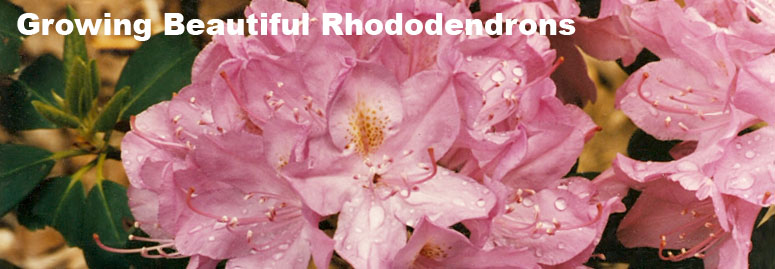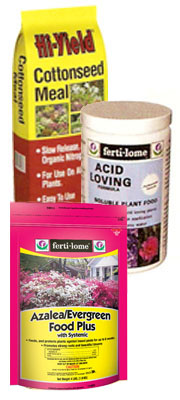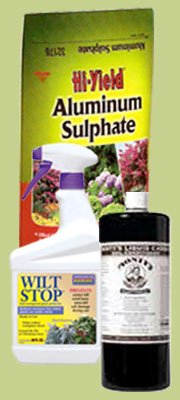
TIPS FOR GROWING BEAUTIFUL RHODODENDRONS
Rhododendrons love a peat moss rich soil with a pH of 5.5 to 6.5. To lower the pH of your soil to this ideal range, apply aluminum sulfate around the base of the plant away from the stem at a rate of 1 pound per 3 feet of height. (Meaning if your rhododendron is 3 feet tall, use 1 pound of aluminum sulfate. If your rhododendron is 6 feet in height, use 2 pounds of aluminum sulfate). Aluminum sulfate may be sprinkled on top of the soil dry or mixed with water. It is very important not to get any aluminum sulfate (or any other dry fertilizer) on the stem or leaves as this can damage or even kill the plant.
Rhododendrons have a root depth of about 6 to 8 inches. With such a shallow root system it is critical to keep the roots evenly moist during draught conditions. Peat moss, which can hold up to 10 times its weight in water, is great for locking in moisture around the roots. When planting new rhododendrons, fill the area around the root ball with a mixture of 50% peat moss and 50% soil to ensure a safe re-rooting process. For already existing rhododendrons, spread a layer of peat moss on top of the soil near the base of the plant. The roots of both newly planted and pre-existing plants will also benefit from having a layer of hardwood bark mulch or chopped leaves spread on top of the soil around their base. If you have already applied a layer of peat moss on top of the soil near the base of your plant then the hardwood bark mulch or chopped leaves may be spread on top of that. To further strengthen the roots, feed your rhododendrons once a month, from April to August, with a liquid fertilizer formulated for acid loving plants. This will also keep the foliage lush and succulent. A regular feeding of a 4-5-4 formulated rhododendron food will build a strong root system as well and give your plants beautiful, vibrant colored blooms. In addition, giving your rhododendrons an application of cottonseed meal in spring and late fall is a great organic way to give your plants a slow continuous feeding of nutrients that lasts throughout the growing season and into the early winter months.

Although rhododendrons keep their leaves all year long, the foliage will still need some protection during the harsh winter months, as the cold temperatures and fierce wind can cause severe winter burn and other damage. Applying an anti-transpirant to the leaves in late October/early November will prevent winter damage on the leaves and help the plant to retain moisture during times of extreme cold, when it is under great stress from lack of water and there is no snow cover. Rhododendrons are highly susceptible to damage from extreme temperatures, so great care must be taken when selecting an area in which to plant them. Rhododendrons should never be placed in a planting where rock is used to top dress the soil, as the excess heat radiating off of the rocks will burn the roots. Rhododendrons should also never be planted in a hot area on the south side of a home or building or placed near an air conditioner. The temperatures common in these locations are far too severe for rhododendrons and will damage or even kill the plant.
Take special care if you are planting your rhododendrons in clay soil. Clay soil retains a high amount of moisture which does not easily drain away. Plants sitting in clay soil oversaturated with water will suffer and eventually die if the excess moisture is not drained off. Rhododendrons planted in clay soil should be placed in the ground in such a way that the top few inches of their root ball sticks out above the soil line. This ensures that the plant will have some area in which the excess water can drain. The exposed portion of the roots should then be covered with potting soil and mulch to protect it from the elements. Mixing liquid carbon into the clay soil when planting or applying it on top of the soil of pre-existing plants will also open water channels as needed to prevent the roots from becoming water logged and rotting away.
Mitchell and Sons uses and recommends Bonide® Wilt Stop RTU (an anti-transpirant), Ferti-lome® Acid Loving Formula Soluble Plant Food, Ferti-lome® Azalea/Evergreen Food Plus with Systemic, Ferti-lome® Peat Moss, Hi-Yield® Aluminum Sulfate, Hi-Yield® Cottonseed Meal, Monty's® Liquid Carbon and Hardwood Bark Mulch for all our rhododendrons.
Back to Gardening Tips Back to Evergreens